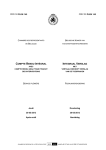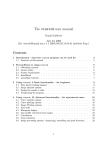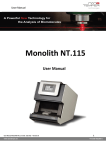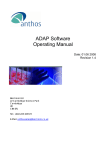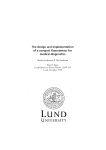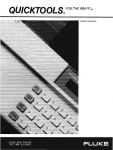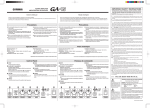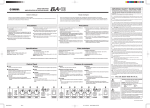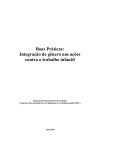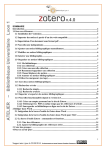Download H E F A
Transcript
H
E
F
A
M.J.Moene
Helium Fluorescentie & Absorptie
Setup • 1
Measurements • 2
Analysis and design • 5
Bibliography • 14
Theory • 17
1. SETUP
The HEFA apparatus offers the ability to measure absorbance, various kinds of fluorescence, linear
dichroism and circular dichroism spectra. Measurements can be done at room temperature as well
as cryogenic temperatures. Figure 1.1 gives an overview of the HEFA apparatus.
La2
T3
F3
La1
T1
S1a M1 S1b
P1
F1
L1 PEM
L2
OG
Sample
D1
Cryostat
L3
F2
P2
La
Lamp
M
Monochromator
S
Monochromator Slit
T
Shutter
M2
P
Polarizer (LD-CD)
F
Filter set
S2a
L
Lens
D
Detector
OG
Opal Glass (scattering samples)
S2b
T2
D2
Figure 1.1 HEFA setup
The following table summarizes the various types of experiments in relation to the components of
HEFA .
Measurement
Type
Lamp
M1
Absorbance
A
La1
scans
D1
Linear Dichroism (LD)
A
La1
scans
Circular Dichroism (CD)
A
La1
scans
Fluorescence emission
F
La1
fixed
scans
D2
Fluorescence excitation
F
La1
scans
fixed
D2
Fluorescence polarization
F
La1
scans
fixed
D2
HEFA
M2
15 March 2006
D
PEM
L o c k-in
D1 (PM)
V
2F
D1 (PM)
V/2
F
1
2. MEASUREMENTS
The following paragraphs describe the setups and measurement procedures to use for the various
measurements. Appendix A. gives a summary of the theory of measurement-methods.
2.1 A b s o r b a n c e
Absorbance spectra are measured with the following setup.
La1
S1a M1 S1b
T1
F1
L1
Sample
MONO-
I / O - BOX
TIMEBASE
ADC
D1
AMPLIFIER
CHROMATOR
CONTROLLER
OUT 0
OUT 1
OUT
TR
IN
OUT I N
Figure 2.1 HEFA absorbance setup
Absorbance, transmittance and absorptance are defined as follows.
A = 10 log
T =
1 −T =
I0
I
absorbance, optical density
I
I0
tranmittance
I0 −I
I0
absorptance
Intensity I0 is measured with a blank sample, intensity I with the sample of interest.
The method used to measure intensity with the photodiode, leads to a signal even in the complete
dark situation. This dark-signal has to be taken into account in the measurement.
The spectra are measured in two parts: a red part and a blue part. At a certain wavelength in the
scan, λcrossover , filters are changed. This is why we speak of a filter set.
2
15 March 2006
HEFA
Below, a simplified version of the measurement procedure is shown.
insert blank sample
determine monochromator slit widths (and gain and filter settings) with blank sample
measure(I0)
insert sample of interest
measure(I)
Where measure(Im ) is as follows:
adc.setLength(L)
timebase.setFrequency(F)
filter.setCrossoverWavelength(? crossover)
for scan = 1 to N do
filter.set(? begin)
monochromator.set(? begin)
shutter.close()
dark-level-begin = 100 x adc.mean() / adc.fullscale()
shutter.open()
for ? = ? begin to ? end step ? step do
filter.set(? )
monochromator.set(? )
Is [? ] = 100 x adc.mean() / adc.fullscale() - dark-level-begin
done
shutter.close()
dark-level-end = 100 x adc.mean() / adc.fullscale()
Im += Is
A = log(I0/I)
done
Primary parameters
Recorded information
N • number of scans
date, start time, end time
λ?begin • begin wavelength [nm]
sample name,
λ?end • end wavelength [nm]
sample OD
λ?step • wavelength step [nm]
temperature [K]
cuvet form, thickness, material
HEFA
Secondary parameters
slit widths M1, M2 [mm]
G • amplifier gain Z • amplifier filter [Hz]
ADC gain (1)
F • ADC sampling rate [Hz]
dark-level-begin
L • samples for adc.mean()
dark-level-end
λ?crossover • filter crossover wavelength [650nm]
λ? - I0 - I, (A)
15 March 2006
3
2.2 L i n e a r d i c h r o i s m
2.3 C i r c u l a r d i c h r o i s m
2.4 F l u o r e s c e n c e e m i s s i o n
2.5 Fluorescence excitation
2.6 Fluorescence polarization
4
15 March 2006
HEFA
3. ANALYSIS AND DESIGN
The HEFA setup enables measuring absorbance spectrum, linear and circular dichroism spectra and
fluorescence emission, excitation and polarization spectra.
The system should enable users
R1. to perform the various absorbance and fluorescence measurements effectively and efficiently.
R2. to save the measurement results and their context to data files.
R3. to view previously made measurements.
3.1 Users and usability requirements
End-users
Two classes of users can be distinguished: HEFA user and Other staff.
HEFA user – those who actually perform measurements with the HEFA setup. The users are
postdocs, Phds and students in physics with various levels of scientific experimental experience. All
are direct users and for most of them – in the order of ten – HEFA is not their primary setup and
they only will use it intermittently. There may be a couple of persons that will be very experienced
with the HEFA setup. All users are experienced computer and MS-Windows users.
Other staff – a class of users that only wants to review previously measured spectra.
Usability requirements
The system should enable both the experienced and the less experienced
user to perform the measurements.
UR1. Low error rate. The system will guide users through the measurement, visualizing the
(partial) results and providing other feedback on what is happening (R1).
UR2. Low error rate. The system will prevent the user to perform invalid actions (R1).
UR3. High efficiency. The system will automate as much as possible and provide remote
UR4.
UR5.
UR6.
UR7.
monitoring. However, also opportunities to enable the very experienced people to do
'unanticipated' things will be looked for (R1).
High efficiency. The system will support measuring and saving the reference signal separately
from the signal with the sample of interest and reloading this signal from a data file (R1).
High efficiency. The system will support saving and loading the program configuration (R1).
Interoperability. Measurement results and their context will be saved to data files in a format
that can be easily used with other programs to enable further processing (R2).
User satisfaction. User will be 'in control'. Improve on existing system.
Evaluation criteria The usability requirements will not be measured.
Level to achieve The usability requirements will not be measured.
3.2 User tasks
Tasks
The user tasks reflect the measurements as can be done with the HEFA setup. Another task
is viewing previously measured spectra. Figure 3.1 on the next page shows the task model for
measure absorbance spectrum.
Task scenarios
HEFA
For now, no scenarios will be made.
15 March 2006
5
Plan 0: 1, 2, 5, or
1, 2, 4, 5, or
0.
1, 3, 4, 5
Absorbance Spectrum
Plan 2: 1–5
1.
Plan 3:1,2 or 2
2.
Prepare
H E F A setup for
absorbance measurement
Goal: obtain the sample's absorbance spectrum
Measure
3.
Plan 4: 1–3
4.
Measure
reference signal
Re-use
reference signal
4.1
Insert
sample of interest
Measure
sample signal
4.2
Specifiy
parameters differing
5.
4.3
Save results
Measure I(?)
from 2.2 or 3.1
3.1
Load reference signal
and measurement
3.2
Check monochromator
slit widths are
parameters from file(s)
2.1
Insert
blank sample
2.2
2.3
Specify
measurement
parameters and context
Adjust
monochromator
still the same
2.4
Measure I0( ? )
slit widths
Tasks are performed at the HEFA setup, partly in the dark.
One reference measurement may be made for several measurements of the sample of interest. Note however that the setup must
be untouched between these measurements, specifically, the monochromator slit widths may not be changed in between.
Figure 3.1
6
Task model for absorbance measurement.
15 March 2006
HEFA
3.3 User objects
Multiple models
UOM 1
UOM 2
HEFA user – direct users that perform measurements.
Other staff – 'viewers'.
User Objects
Source
User Object
Attributes
Users
Measurement
number of scans
wavelength range (from, to, step)
Context
(measurement information)
date
time from
time to
sample
sample OD
sample temperature
monochromator slit widhts
Configuration
ADC number of samples
ADC sampling rate,
filter set crossover wavelength
filter set peak transmittance wavelength
data directory
Reference signal
Sample signal
Absorbance signal
Data file
Context file
Task models
—
—
Data model
—
—
HEFA
15 March 2006
7
Absorbance
Measurement
has
has
Configuration
measures
Measurement Context
Figure 3.2
displays
saves
Reference Spectrum
Spectra Views
Spectra Data
Sample Spectrum
Progress Indicator
Status Bar
Context Data
User object model for absorbance measurement.
Absorbance Measurement attributes
•
•
•
•
Number of scans
Spectrum begin wavelength
Spectrum end wavelength
Spectrum wavelength stepsize
Aborbance Measurement actions
Load
Purpose is to load a reference signal into the buffer and skip measuring one.
Input — filename.
Effects — this loads a reference signal into the reference buffer and displays the
spectrum. Further it makes changing the wavelength range impossible. A
measurement now will consist of only the scans for the sample of interest.
Output — reference spectrum loaded and displayed.
Unload
Purpose is to unload the reference signal from the buffer.
Input — none.
Effects — this removes the reference signal from the reference buffer and the
spectrum view. It enables changing the wavelength range again. A measurement now
will consist of a light beam intensity adjustment, a reference measurement and a
measurement of the sample of interest.
Output — reference spectrum loaded and displayed.
Run
Purpose is to start a measurement.
Input — the attributes.
Effects — depending on the measurement procedure, this performs a light beam
intensity adjustment procedure, and a blank sample reference measurement, or
loading of a reference spectrum, and the measurement of the intensity spectrum of
the sample of interest and the construction of the absorbance spectrum. Spectra are
also displayed.
Output — spectra collected and displayed.
8
15 March 2006
HEFA
Continue
Purpose is to make extra measurement scans, either after a Stop, or when the number
of scans has been incremented after completing the previously specified number of
scans.
Rest as within Run.
Save
Purpose is to save the measurement results.
Input — spectra and measurement context.
Effects — save data and context to files in the datadirectory. Automatically generate
names like 001231xy.000 for the data and 001231tx.000 for the context files.
The naming scheme is {year}{month}{day}{code}.{sequence}.
Ask for confirmation to save the data to these files and allow for changing the names
and directory.
Output — data and context files.
Stop
Purpose is to complete current scan, then stop or continue the current measurement.
Input — none
Effects — complete the current scan, further behave as if the measurement is
completed, so the sprectra can be saved.
Output — none
Stop now
Purpose is to terminate measurement immediately without completing current scan.
Input — none
Effects —interrupt the current scan and discard it, further behave as if the
measurement is completed, so the sprectra can be saved.
Output — none
HEFA
15 March 2006
9
Aborbance Measurement dynamic modeling
Action
State-dependency
Load
only if idle
Unload
only if idle
Run
only if idle
Continue
only if Waiting,
Save
only if measurement completed
Stop
only if Scanning or Waiting
Stop now
only if Scanning or Waiting
State
Action
Next state
Outputs
Idle
Load
Idle
disable wavelength inputs
Unload
Idle
enable wavelength inputs
Run, ref. unloaded
Inserting blank
light measuring reference LED
Run, ref. loaded
Inserting sample
light measuring sample LED
Cancel
Idle
clear all LEDs
Done
Adjusting
—
Cancel
Idle
clear all LEDs
Done
Scanning blank
—
all scans completed
Waiting blank
Run ? Continue
Stop now
Waiting blank
Run ? Continue
Stop
Stopping blank
discard partial scan
Stopping blank
this scan completed
Waiting blank
Run ? Continue
Waiting blank
Continue
Scanning blank
—
Stop, Stop now
Inserting sample
light measuring sample LED
Cancel
Saving
light ready LED, Continue ? Save
Done
Scanning sample
—
all scans completed
Waiting sample
Run ? Continue
Stop now
Waiting sample
Run ? Continue
Stop
Stopping sample
discard partial scan
Stopping sample
this scan completed
Waiting sample
change Run ? Continue
Waiting sample
Continue
Scanning sample
—
Stop, Stop now
Saving
light ready LED, Continue ? Save
Cancel
Idle
? ? Run
OK
Idle
? ? Run
Inserting blank
Adjusting blank
Scanning blank
Inserting sample
Scanning sample
Saving
10
Load
Loading
Idle
actions done
Cancel
15 March 2006
Unload
Unloading
actions done
HEFA
Idle
Run, ref. unloaded
Measuring
Reference
Inserting
blank
Stop
Next
Stop
Adjusting
Next
Stop
Stopping
Scanning
blank
blank
Stop now
All scans completed
Scan completed
Continue
Waiting
blank
Stop
Next
Run, ref. loaded
Inserting
sample
Stop
Measuring
Sample
Next
Stop
Stopping
Scanning
sample
sample
Stop now
All scans completed
Scan completed
Continue
Waiting
sample
Next
Cancel
Saving
OK
Figure 3.3
HEFA
Measurement statechart.
15 March 2006
11
Abbreviations
ADC
CD
DAC
analog to digital converter
circular dichroism
digital to analog converter
LD
linear dichroism
OD
optical density
PEM
photo elastic modulator
Glossary of user terms
Absorbance
Amplifier
Analog to digital
conver ter
Blank sample
Circular Dichroism
Configuration
Context
Crossover wavelength
Cryostat
Data directory
measurement method based on effect that sample absorbs energy of light
passing it, exciting pigment molecules, defined as:
10
log Intensityreference (λ)/ Intensitysample (λ).
RULBUS programmable amplifier, lock-in amplifier.
RULBUS module to convert analog voltage to a computer readable number.
cuvet with buffer or solvent only to measure reference signal.
absorbance type measurement method using modulated polarized light.
measurement parameters and information and program settings.
information concerning the measurement, like temperature etc.
wavelength at which the red and blue filters are changed;
attribute of filter set.
device to cool sample to a very low temperature.
directory to save files with measurement results and its context.
Detector
the light detector used: photo-diode or photo-multiplier for LD / CD .
Dichroism
linear, circular.
Filter
Filter set
Fluorescence
optical device to pass part of the spectrum of a light beam.
assembly with two filters, one of which can be selected.
e.g. for the red and blue parts of a spectrum.
effect that sample emits light when relaxing from excited to ground state.
Fluorescence emission
fluorescence type of measurement method.
Fluorescence excitation
fluorescence type of measurement method.
Fluorescence polarization
fluorescence type of measurement method.
I/O controller box
Lamp
Lens
Linear Dichroism
Lock-in amplifier
Monochromator
12
RULBUS module for digital in- and output (SIFU ).
light source to illuminate the sample with monochromatic or actinic light.
optical device to focus light beam or make it parallel.
absorbance type measurement method using modulated polarized light.
amplifier with synchronic detection of modulated signal.
optical device to produce a monochromatic light beam. See also Slit.
15 March 2006
HEFA
Glossary of user terms
Monochromator
controller
Optical density
Photo-elastic modulator
Polarizer
Programmable amplifier
Pump
Reference
Sample
Samples
Sampling rate
Scans
Shutter
Slit
Spectrum
Peak transmission
wavelength
Timebase
Transmittance
Wavelength
RULBUS module to control a Bausch & Lomb monochromator remotely.
optical attribute of a sample, defined as
xxxxx.
electronic/optical device to control polarization of a light beam.
optical device to influence polarization of a light beam.
RULBUS module with programmable amplification factor and low pass filter.
pump with control unit to produce vacuum for ????.
intensity of a blank sample measured over a wavelength range.
cuvet with organic sample of which absorbance etc. is to be determined.
number of samples the ADC reads each wavelength point (attribute of ADC ).
number of samples the ADC reads each second (attribute of ADC ).
number of signal measurements to average over.
mechanical device to block or pass a light beam.
opening in monochromator's light beam of which the width can be adjusted
mechanically. A monochromator has an input and an output slit.
intensity, absorbance etc. signal over a wavelength range.
wavelength at which the filter set has the highest transmission;
attribute of filter set.
RULBUS module to generate timing pulses for the ADC trigger input.
effect that sample absorbs energy from light passing it, defined as:
Intensitysample(λ) / Intensityreference (λ).
wavelength of the light leaving the monochromator, or of the light emitted
by the sample.
3.4 Style guide
The style guide is only touched here very briefly.
GUI
environment
Expected style
Window look
LabVIEW under MS-Windows.
Users will expect a Virtual Instrument front-panel presentation.
Instrument-like front-panel with TABS to access various parts.
Standard menu items
Window controls
No menus will be used.
TABS , entry and display fields, drop-down lists, buttons.
Standard pattern of interaction
(to be filled.)
Help system
LabVIEW help system with tip strips and descriptions. All window controls.will
provide appropriate help information.
HEFA
15 March 2006
13
3.5 D e s i g n G U I
•
•
•
•
Supports user tasks.
Presents the user's objects clearly.
Conforms to the style guide.
Meets usability requirements.
•
•
•
•
•
What views of objects are required for tasks?
How should these views be allocated to windows?
What layout should be used for windows?
How does the user navigate from one window to another?
What menu items and other controls are required, and how do they behave?
• Window designs, including specification of interactive behaviour.
• Window navigation design.
3.6 P r o t o t y p e G U I
•
•
•
•
•
•
•
How can the user perform the task scenarios using the G U I ?
Are extra views of objects required?
Should the windows be restructured to support tasks better?
Is the inter-window navigation adequate to support tasks?
How can 'what the person does' be simplified and streamlined?
What problems does the user encounter?
What improvements does the user suggest?
• A working prototype G U I
• Revisions to the G U I design
3.7 E v a l u a t e G U I
• How usable is the G U I by the end-users, in terms of the usability criteria previously specified?
• What usability problems do users encounter?
• Does the G U I provide adequate support to all types of users performing their full range of tasks?
• An evaluation of the usability of the G U I design and prototype.
• Usability problems.
• Proposed revisions to the G U I design.
4. BIBLIOGRAPHY
1.
2.
3.
4.
5.
6.
7.
Hjalmar P. Permentier, 2001, HEFA User Manual, version 2.0.
Kristiane A. Schmidt, 1998, Data Conversion for HEFA .
authors unknown, 1996–2000, Source of program for HEFA , hefanew.pas
Hjalmar P. Permentier, 2000, Source of program for HEFA data manipulation on PC hefa2.pas.
Eric M. Franken, 1998, documentation and source of meas_spc .pas program for HEFA / SNAFA .
Stephan C.M. Otte, 1992, Doctoral Thesis, University of Leiden.
J.C van der Heiden, 1991, Optical study of the antenna systems of photosynthetic bacteria.
Describes theory of measuring-methods, pp. 3–7.
8. Tom Eijkemans, 1988, Efficiëntere automatisering van de HEFA -opstelling.
9. David Redmond-Pyle, Alan Moore, 1995, Graphical User Interface Design and Evaluation
(GUIDE ), A Practical Process, Prentice Hall Europe, Hemel Hempstead, Great Britain, 1995,
ISBN 0-13-315193-X
14
15 March 2006
HEFA
A . THEORY OF MEASUREMENT-METHODS
Photosynthesis
Photosynthesis is the process in which plants and some types of bacteria transfer the energy of
(sun)light into chemical energy used for maintaining and the reproduction of the organism.
Photosynthetic organisms can be divided into two groups according to the type of photosynthetic
reaction applied by these organisms, the first group being the photosynthetic bacteria and the
second group consists of algeae and higher plants. The latter group produces oxygen as a sideproduct of the photosynthetic reaction.
Independent of the type of photosynthetic reaction used, the photosynthetic system can always be
divided into two parts, firstly the antenna and secondly the reaction center. In the antenna light is
gathered through absorption by pigments, placing them in an excited state. These excitations are
then transferred to the reaction center in which the energy is used to make a charge separation
which can subsequently induce chemical reactions.
Light can be absorbed in the cell by different pigments, but all organisms contain at least one
chlorophyll-like pigment and in most species carotenoids are present as well. Algeae and higher
plants contain chlorophyll a (Chl a), and some species chlorophyll b as well. In bacteria more
different types of bacteriochlorophyll (BChl) are found, BChl a through g. In most bacteria more
than one type of pigment is present.
T h e o r y o f m e a s u r i n g -m e t h o d s
In this report the photosynthetic system is looked at from a physics viewpoint, using physical
experiments to obtain information about the system. The first process that occurs is of course the
absorption of light by the pigments in the antenna. The pigment molecule comes in an electronic
excited state and the energy can then either be transferred to another molecule or several other
processes can occur. In this report we will confine ourselves to the transfer of energy to other
molecules and only one of those other processes, fluorescence. An (overly) simplified energy
scheme is presented in Figure A.1.
S3
S1
relaxation
Vibrational
S2
S0
Figure A.1
HEFA
Phosphorescence
Fluorescence
Absorption
Energy
T0
Energy scheme of a pigment molecule
15 March 2006
15
Absorbance
Normally a molecule is in the state with the lowest energy, the ground state called S0. Absorption of
a photon excites the molecule to a higher energy level. Depending on the energy, and therefor on
the wavelength (E = hc/λ), of the absorbed photon the pigment is excited from S0 into one of the
higher energy s t a t e s S1, S2, S3 etc. Measuring the absorption of light while scanning through a
wavelength interval produces an absorption spectrum. The absorbance A is proportional to the
specific extinction eε of the sample at the wavelength at which absorption is measured. Two other
properties the absorbance is proportional to are the concentration c of the sample and the optical
pathlength l of light in the sample. For a parallel beam of light this dependence is expressed in
v.Beer's law
I
A =10 log 0 = ε ⋅ c ⋅ l
I
in which I0 and I are the intensities of light going in respectively coming out of the sample.
Because of interactions of the pigment with it's environment and because of thermal effects the
spectrum will not be made up of sharp absorption lines but of gaussian shaped bands. The band
formed by exciting a molecule to the S1 state is called the Qy band. Excitation to S2 gives rise to the
Qx band, and excitation to S3 produces the Soret band, which is actually composed of two bands, Bx
and By . Figure 2 shows the general shape of an absorption spectrum of the BChl a protein of the
green sulfur bacterium Prostecochloris aestuarii.
0,5
Qy
Absorbance
0,4
0,3
0,2
Soret
Qx
0,1
0,0
400
500
600
700
800
900
Wavelength [nm]
Figure A.2 Absorption spectrum of the BChl a protein from Prostecochloris aestuarii
at room temperature
Each different type of molecule has different energy levels and therefor a different absorption
spectrum. As a result the absorption spectrum can be used to get a general idea of the molecular
contents of a sample.
Fluorescence
emission
Once a molecule is in an excited state it will not remain there indefinitely but will relax to a state of
lower energy until the ground state is reached. Relaxation from S3 a n d S2 t o S1 takes place by
vibrational relaxation. In the S1 state a molecule can either emit a photon, which is called
fluorescence, or it can relax to the ground state of the triplet, T0. Emission of a photon from T0,
called phosphorescence, can then occur. A fluorescence emission spectrum is obtained by
measuring the emission of fluorescence at varying wavelength while exciting the sample at one
wavelength (e.g. in the Qx band).
16
15 March 2006
HEFA
Emitting a photon represents a loss of energy to the photosynthetic process. A pigment can also
relax to the ground state by transferring the energy to another molecule. It is this process which
enables the photosynthetic system to transfer energy from the antenna to the reaction center. The
efficiency of the photosynthetic process is directly dependent on the efficiency of this energy
transfer.
Once the fluorescence emission spectrum is known, the intensity of light emitted at the maximum
(or one of the maxima) of the fluorescence emission spectrum can be measured while varying the
excitation wavelength. This produces a fluorescence excitation spectrum. From this spectrum the
efficiency of energy transfer from states of higher energy to the fluorescing state (S1) of a pigment,
or, more important, from another pigment to the fluorescing pigment can be derived.
Fluorescence
excitation
The fluorescence excitation is not proportional to the absorbance A, which is presented in the
absorption spectrum but to the absorptance 1–T, since fluorescence takes place on a linear scale.
The 1–T spectrum can be calculated from the absorption spectrum by using the formula
T = 10 − A
Both spectra are normalized at the peak corresponding to the emitting state. The fluorescence
excitation spectrum will be identical to the absorption spectrum if the efficiency of energy transfer
from the absorbing state to the emitting state is 100%. For lower efficiency the amplitude in the
excitation spectrum is correspondingly lower. Relative amplitudes of peaks in the spectra can then
be used to calculate the efficiency of energy transfer.
The two basic measuring methods, absorption and fluorescence excitation, can be elaborated on by
using polarized light. For fluorescence excitation this results in fluorescence polarization spectra. A
sample is excited by plane-polarized light and emission of plane polarized light parallel and
perpendicular to the exciting light is then measured. The polarization p can be defined as
p=
Fluorescence
polarization
I || − I ⊥
I || + I ⊥
where I|| and I⊥ stand for the intensities of the emitted light polarized parallel respectively
perpendicular to the exciting light for a 'random', isotropic system of unmoving, isolated
molecules the following equation holds
p=
3 cos 2 α − 1
2
cos α + 3
where αa is the angle between the transition moments of the absorption- and the fluorescencedipole. This way relative angles of the dipoles formed by molecules and their electrons can be
ca1culated.
In absorption measurements one can use either plane polarized or circular polarized light. The
difference in absorption of horizonta1ly and vertica1ly plane polarized light is ca1led linear
dichroism (LD ) and the difference in absorption of left and right circular polarized light is ca1led
circular dichroism (CD ).
LD measurements require a sample with an orientation superimposed on it. This is usually done by
placing the sample in a gel with a rigid structure of polymers. The particles of the sample are held
within this structure. Pressing the gel in one or two directions (uni- or biaxia1 pressing) will stretch
this structure in the other direction(s) imposing a orientation on the particles of the sample. One
can then define the linear dichroic rate (LDR or anisotropy) as
HEFA
15 March 2006
17
LD/CD
LDR =
A || − A ⊥ 3
= (1 − 3 cos 2 φ )
A
2
in which A is the absorbance of the sample and φf the angle between the transition dipole and the
normal to the plane of the membrane. A? a n d A? are the absorbances of plane polarized light
parallel or perpendicular to the superimposed orientation. When the orientation of the sample by
pressing is not perfect, information derived from an LD spectrum will be qualitative and not
quantitative. A positive signal indicates a small angle between the transition dipole and the plane of
the membrane, a negative signal indicating a larger angle.
Optical study of the antenna systems of photosynthetic bacteria, pp. 3–7. J.C van der Heiden, 1991.
18
15 March 2006
HEFA


















